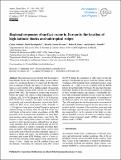Por favor, use este identificador para citar o enlazar a este item:
http://hdl.handle.net/10261/184984COMPARTIR / EXPORTAR:
 SHARE SHARE
 CORE
BASE CORE
BASE
|
|
| Visualizar otros formatos: MARC | Dublin Core | RDF | ORE | MODS | METS | DIDL | DATACITE | |

| Título: | Regional responses of surface ozone in Europe to the location of high-latitude blocks and subtropical ridges |
Autor: | Ordóñez, C. CSIC ORCID; Barriopedro, David CSIC ORCID ; García Herrera, Ricardo CSIC ORCID; Sousa, Pedro M.; Schnell, Jordan L. | Fecha de publicación: | 28-feb-2017 | Editor: | European Geosciences Union | Citación: | Atmospheric Chemistry and Physics 17: 3111-3131 (2017) | Resumen: | This paper analyses for the first time the impact of high-latitude blocks and subtropical ridges on near-surface ozone (O3) in Europe during a 15-year period. For this purpose, a catalogue of blocks and ridges over the Euro–Atlantic region is used together with a gridded dataset of maximum daily 8h running average ozone (MDA8 O3) covering the period 1998–2012. The response of ozone to the location of blocks and ridges with centres in three longitudinal sectors (Atlantic, ATL, 30–0°W; European, EUR, 0–30°E; Russian, RUS, 30–60°E) is examined. The impact of blocks on ozone is regionally and seasonally dependent. In particular, blocks within the EUR sector yield positive ozone anomalies of ∼ 5–10ppb over large parts of central Europe in spring and northern Europe in summer. Over 20 and 30% of the days with blocks in that sector register exceedances of the 90th percentile of the seasonal ozone distribution at many European locations during spring and summer, respectively. The impacts of ridges during those seasons are subtle and more sensitive to their specific location, although they can trigger ozone anomalies above 10ppb in northern Italy and the surrounding countries in summer, eventually exceeding European air quality (AQ) targets. During winter, surface ozone in the north-west of Europe presents completely opposite responses to blocks and ridges. The anticyclonic circulation associated with winter EUR blocking, and to a lesser extent with ATL blocking, yields negative ozone anomalies between −5 and −10ppb over the UK, northern France and the Benelux. Conversely, the enhanced zonal flow around 50–60°N during the occurrence of ATL ridges favours the arrival of background air masses from the Atlantic and the ventilation of the boundary layer, producing positive ozone anomalies of ∼ 5ppb in an area spanning from the British Isles to the northern half of Germany. We also show that multiple linear models on the seasonal frequency of occurrence of these synoptic patterns can explain a considerable fraction of the interannual variability in some winter and summer ozone statistics (mean levels and number of exceedances of the 90th percentile) over some regions of western Europe. Thus, this work provides the first quantitative assessments of the remarkable but distinct impacts that the anticyclonic circulation and the diversion of the zonal flow associated with blocks and ridges exert on surface ozone in Europe. The findings reported here can be exploited in the future to evaluate the modelled responses of ozone to circulation changes within chemical transport models (CTMs) and chemistry–climate models (CCMs). | Versión del editor: | https://doi.org/10.5194/acp-17-3111-2017 | URI: | http://hdl.handle.net/10261/184984 | DOI: | 10.5194/acp-17-3111-2017 | ISSN: | 1680-7316 1680-7324 |
| Aparece en las colecciones: | (IGEO) Artículos |
Ficheros en este ítem:
| Fichero | Descripción | Tamaño | Formato | |
|---|---|---|---|---|
| Regional responses_Ordoñez.pdf | 4,96 MB | Adobe PDF |  Visualizar/Abrir |
CORE Recommender
SCOPUSTM
Citations
26
checked on 25-mar-2024
WEB OF SCIENCETM
Citations
24
checked on 27-feb-2024
Page view(s)
175
checked on 23-abr-2024
Download(s)
126
checked on 23-abr-2024
Google ScholarTM
Check
Altmetric
Altmetric
Este item está licenciado bajo una Licencia Creative Commons

